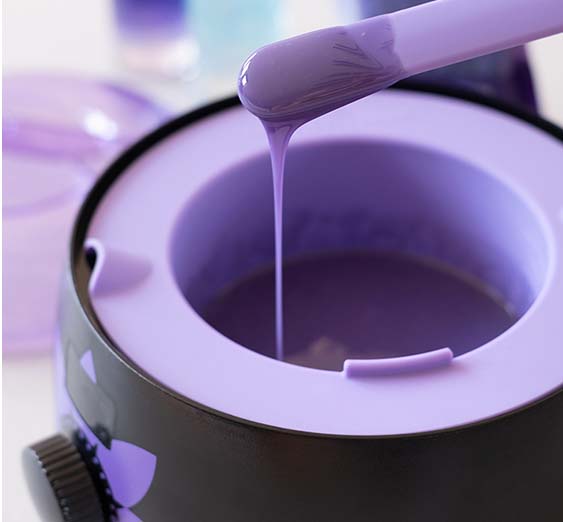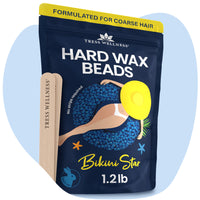Are you tired of constantly battling PCOS-related hair growth? Discover how waxing might offer a suitable solution for your needs. With insights into the benefits and techniques of pcos waxing, this article is crafted to guide you through effective hair management without overwhelming detail.
Key Takeaways
-
Polycystic Ovary Syndrome (PCOS) commonly causes hirsutism, or excessive hair growth, due to high levels of androgens and insulin resistance, which can be managed through insulin-sensitizing treatments and lifestyle changes.
-
Waxing is an effective hair removal method for women with PCOS, offering long-lasting results and the potential for reduced and finer hair regrowth over time, adaptable to different skin types and hair colors.
-
When waxing to manage PCOS-induced hirsutism, it is important to prepare the skin properly, use the correct techniques to minimize discomfort and follow up with post-wax care to soothe the skin and prevent ingrown hair.
Understanding PCOS and Hirsutism

Polycystic Ovary Syndrome (PCOS) is a hormonal disorder, primarily affecting women of reproductive age. Symptoms include irregular periods, oily skin, and hirsutism, which is particularly relevant to our topic. Hirsutism, characterized by excessive growth of facial or body hair in women, is a common symptom of polycystic ovary syndrome, affecting 70 to 80% of women with the condition.
This excess hair growth, including unwanted hair growth and excess facial hair growth, is primarily caused by elevated levels of androgens and insulin resistance, both prevalent in women with PCOS.
The Role of Androgens
In women with PCOS, androgens or ‘male hormones’, significantly contribute to the onset of hirsutism. These hormones may cause some vellus hairs, often referred to as ‘peach fuzz’, to transform into dark hair, which is longer, darker, and coarser.
The sensitivity of the hair follicle, or pilosebaceous unit, varies among individuals, and increased sensitivity can lead to hirsutism in women with PCOS.
Insulin Resistance and Hair Growth
Another factor influencing the hirsutism-PCOS connection is insulin resistance. Women with PCOS typically have higher levels of insulin resistance than those with idiopathic hirsutism, suggesting a stronger link between insulin resistance and hirsutism in PCOS. These high insulin levels contribute to excess hair growth.
However, there’s a silver lining: managing insulin resistance can help reduce hair growth. This can be achieved using insulin-sensitizing drugs like metformin, following a low glycemic index diet, and making lifestyle changes such as weight loss.
Waxing as a Solution for PCOS Hair Removal
Having explored the reasons for unwanted hair growth in women with PCOS, let's look at a helpful option: waxing. This method of hair removal is quick, works well, and is easy to find, providing results that last for a while. This is especially useful for those dealing with the fast and unusual hair growth that comes with PCOS.
With consistent waxing, the hair can grow back less often and become thinner, which is a big help in controlling the hair growth that PCOS causes.
Take a look at how Daquana does it with the Tress Wellness Waxing kit:
Why Waxing is the Best Hair Removal Method for PCOS
Waxing offers several benefits compared to other hair removal methods like shaving, laser treatments, and electrolysis. Shaving can cause hair to grow back quickly and leave rough stubble, but waxing pulls hair out from the root, giving you smoother skin for longer, usually three to six weeks. This is particularly helpful for those dealing with fast hair growth from PCOS.
Laser hair removal and electrolysis might last longer, but they are more expensive and don't work for everyone. Laser treatments work best on people with dark hair and light skin and might not be right for those with PCOS. Electrolysis, which treats each hair one at a time, can be slow and painful, especially for large areas.
Waxing can be done at home or by professionals, making it convenient. Regular waxing can even make hair grow back less often and thinner, which is great for managing PCOS hair growth. It's also good for all skin types and hair colors, unlike laser treatments which have more limitations.
In short, waxing is a top choice for those with PCOS because it's more affordable, flexible, and good for different skin and hair types. It gives lasting results and can even make hair grow back less and finer, helping to control PCOS hair growth.
Types of Wax for PCOS Hair Removal

For women with PCOS, hard wax is often considered the best option for hair removal. This type of wax is particularly effective for strong, coarse hair, which is common in PCOS-induced hirsutism. Hard wax adheres well to the hair but not to the skin, reducing the discomfort typically associated with waxing. It's also excellent for sensitive areas, making it ideal for facial hair removal where the skin may be more prone to irritation and redness.
Moreover, hard wax is known for its ability to remove even the shortest hair, which means fewer sessions are needed over time, contributing to a slower regrowth rate. This can be particularly beneficial for managing the rapid hair growth associated with PCOS. Hard wax does not require strips for removal, which can be an advantage for those who find strip waxing too harsh on the skin.
Tress Wellness Hard Wax beads are formulated especially to target thick and coarse hair while being gentle on the skin. Tress Wellness Bikini Star Beads are perfect for sensitive areas like face and bikini region.
Overall, hard wax offers a more targeted, less painful hair removal experience, with reduced chances of redness or irritation, making it a superior choice for managing the unwanted facial hair that often accompanies PCOS. We also have a blog on how to use the Tress Wellness Waxing Kit, check it out before getting started.
Face Waxing for PCOS: Tips and Techniques

The process of face waxing for PCOS demands careful consideration and precision. Before initiating the waxing process, it’s important to have a professional consultation to address individual concerns such as hair texture, thickness, and skin sensitivity.
Selecting a wax designed for sensitive skin can significantly reduce the risk of irritation during the waxing process for women with PCOS.
Preparing Your Skin
Preparing the skin is an essential step prior to waxing. Cleansing the skin, especially for clients with PCOS who may have oilier skin, prepares the surface for waxing and ensures the wax adheres properly. Exfoliation also helps remove dead skin cells that can block hair follicles, leading to more effective waxing and reducing the likelihood of ingrown hairs.
Moreover, avoiding stimulants such as caffeine and alcohol prior to the waxing session can help reduce skin sensitivity and pain during waxing.
Proper Wax Application and Removal
The correct technique for wax application and removal is crucial for face waxing. For PCOS-related facial hair, a peelable or flexible wax is recommended as it is better at grabbing strong hair and is gentler on sensitive skin.
Here's how you should do it:
1. Heat the Wax: If you're using a wax warmer, turn it on and let the wax heat up until it reaches a honey-like consistency. If you're using microwaveable wax, follow the instructions on the package for heating times. Read more on the perfect hard wax temperature.
2. Divide and Conquer: To ensure an effective and manageable face waxing session, it's best to divide your face into sections such as the upper lip, chin, cheeks, and forehead. Work on one section at a time, applying and removing the wax before moving on to the next area. This approach offers greater control over the process and helps to achieve more precise results.
3. Apply the Wax: Using a spatula or applicator stick, apply a thin layer of wax in the direction of hair growth. Make sure to leave a bit of extra wax at the end of the strip, this will be your "tab" for removal.
4. Remove the Wax: Wait for the wax to cool slightly, then pull the skin taut with one hand and quickly remove the wax in the opposite direction of hair growth with the other hand. Remember, the faster you pull, the more effective the hair removal will be.
5. Soothe Your Skin: After waxing, apply a soothing lotion or aloe vera to help calm any redness or irritation. Avoid any harsh skincare products or sun exposure for at least 24 hours after waxing.
Here's a visual tutorial on how to apply and remove wax from face with excessive hair growth:
There you go! Your step-by-step guide to face waxing at home. We do a bunch of blogs on waxing body parts. Get your own guide to waxing down there, leg waxing, arm waxing and waxing for men like chest waxing and back waxing. Check out all our blogs!
Post-Wax Care
Ensuring effective hair removal and minimizing irritation also depends greatly on post-wax care. Applying an after-wax cream containing soothing ingredients like aloe vera and nourishing oils post-waxing helps calm and hydrate the skin. Cooling gels or a cold compress may be applied immediately after waxing to soothe the skin and close the pores, helping to reduce redness and swelling.
The Tress Wellness After-Waxing Spray is packed with the goodness of aloe vera and chamomile to soothe your skin and nourish it.
To prevent ingrown hairs and unwanted hair, regular exfoliation and avoiding tight clothing that can cause friction are recommended post-waxing.
Practicing Self-Love and Acceptance
Balancing the management of PCOS’s physical symptoms with the nurturing of emotional well-being is of paramount importance. Building self-esteem involves:
-
Embracing one’s unique characteristics
-
Focusing on personal talents, qualities, and accomplishments
-
Using positive affirmations to significantly impact mental health and reaffirm self-love and belief
This is especially useful for those dealing with PCOS.
Engaging in new hobbies or activities can lead to increased self-esteem and a sense of empowerment, encouraging women with PCOS to venture beyond their usual comfort zones. Some ways to do this include:
-
Trying out a new sport or exercise routine
-
Taking up a creative hobby like painting or writing
-
Joining a book club or other social group
-
Volunteering for a cause you care about
Improving self-esteem and finding purpose may also come from productive work, study, or volunteering, coupled with setting personal boundaries and indulging in self-care rituals daily.
Frequently Asked Questions
Does PCOS cause more pubic hair?
Yes, PCOS can cause an increase in pubic hair due to the excess male sex hormones it produces.
Can you wax someone with hirsutism?
Waxing someone with hirsutism can have mixed results, potentially causing damage to hair follicles and leading to ingrown hairs or permanent skin damage. Be cautious when considering waxing for hirsutism.
Is waxing better for PCOS?
Yes, waxing is a better hair removal option for PCOS due to its long-lasting results, accessibility, and cost-effectiveness compared to laser hair removal or constant shaving.
What causes excess hair growth in women with PCOS?
Excess hair growth in women with PCOS is primarily caused by elevated levels of androgens and insulin resistance, leading to hirsutism.
How does waxing help manage PCOS-related hair growth?
Waxing can help manage the rapid and abnormal hair growth patterns characteristic of PCOS by leading to less regular and finer hair growth over time.
In sum, women with PCOS can effectively manage unwanted hair growth through regular waxing sessions, proper skincare, and the right waxing techniques. Waxing offers numerous advantages over other hair removal methods, such as accessibility, quick results, and suitability for various skin types and hair colors. But beyond these physical strategies, it’s important to remember the value of self-love and acceptance. By embracing your unique characteristics and engaging in activities that boost self-esteem, you can navigate the challenges of PCOS.




